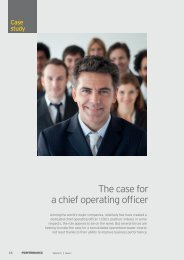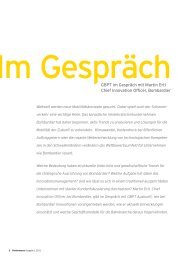PERF RMANCE 04 - The Performance Portal - Ernst & Young
PERF RMANCE 04 - The Performance Portal - Ernst & Young
PERF RMANCE 04 - The Performance Portal - Ernst & Young
You also want an ePaper? Increase the reach of your titles
YUMPU automatically turns print PDFs into web optimized ePapers that Google loves.
“ <strong>The</strong> true benefit of the EVA is the<br />
ease with which it can be calculated<br />
and communicated.”<br />
<strong>The</strong> economic profit is excess of NOPAT<br />
over capital costs (invested capital x<br />
WACC), and therefore represents the<br />
return the firm has to generate in order to<br />
satisfy its shareholders who have “rented”<br />
capital to the firm. In practice, the true<br />
benefit of the EVA is the ease with which it<br />
can be calculated and communicated. <strong>The</strong><br />
process of value creation quickly and easily<br />
becomes apparent. Value drivers can be<br />
characterized by profit maximization, by<br />
the decrease in the capital invested, or by<br />
the reduction of the WACC.<br />
Using the EVA terminology, the investors’<br />
expectations are taken into account with<br />
the Market Value Added (MVA). This<br />
approach relates to the market value<br />
minus capital:<br />
MVA = Market Value – Capital = present value<br />
of all future EVAs = ∞ EVA<br />
(1 + WACC)<br />
In this way, future EVAs are estimated. If<br />
the increase in market value is added to the<br />
business assets (BA) of a company, then we<br />
can arrive at the firm value (FV) (Faupel et<br />
al. 2010, p. 59):<br />
FV = BA + MVA<br />
<strong>The</strong> adoption by businesses of EVA will<br />
assist in the decision-making process by<br />
encouraging decision-making which is<br />
better aligned to maximizing shareholder<br />
value. One of the main benefits of EVA<br />
is greater transparency, which means<br />
shareholders have a much better<br />
understanding of the business and its<br />
interaction with external influences<br />
(which could also be viewed as external<br />
costs). In addition, EVA represents a very<br />
flexible index as it can adjust to particular<br />
requirements using specific conversions.<br />
<strong>The</strong> EVA index provides great potential<br />
for integration with not only the absolute<br />
but also the relative SVA. Although both<br />
concepts are backward looking (the<br />
conventional method of SVA always<br />
measures the SVA of the previous period<br />
instead of the current period), a clear<br />
difference exists. While the new concept<br />
of the SVA represents a dynamic process,<br />
as shown in formula (3), the EVA index<br />
does ignore periodical interdependencies.<br />
<strong>The</strong> introduction of the MVA attempts to<br />
compensate for this problem with the EVA.<br />
By incorporating the future perspective<br />
provided by the SVA, an analogue model<br />
to the MVA index could be derived. <strong>The</strong><br />
concept of the Total Sustainable Value<br />
Added (TSVA = a company’s contribution<br />
to increased sustainability in total) could be<br />
calculated as follows:<br />
MSVA = MSV — Resources = present value of<br />
all future SVAs= ∞ SVA<br />
(1 + WACR)<br />
Where:<br />
MSVA = Market SVA = market's<br />
contribution to more sustainability<br />
WACR = weighted average cost of<br />
resources 2<br />
By estimating all future SVAs, the increase<br />
in the MSVA is taken together with the<br />
resources a company owns (resources<br />
owned = RO) resulting in the TSVA:<br />
TSVA = RO + MSVA<br />
In this way, a method for measuring the<br />
performance of a company’s contribution<br />
to increased sustainability in total is<br />
achieved. If the SVA is adopted in addition<br />
to the EVA or the MVA, when measuring<br />
performance, companies will see increased<br />
motivation among employees and will be<br />
in a better position to facilitate a dialogue<br />
with shareholders.<br />
Realizing synergies<br />
<strong>The</strong> links between the concept of SVA,<br />
shareholder value management and EVA<br />
provide enormous potential for synergies.<br />
<strong>The</strong> concept of SVA goes well beyond<br />
the generally accepted standard tools for<br />
performance measurement, which typically<br />
consider only return on capital. It is not<br />
just the opportunity cost considerations<br />
but also the introduction of the three<br />
dimensions of corporate sustainability<br />
which make the use of SVA so unique. As a<br />
consequence, what is normally a restricted<br />
view of standard financial performance<br />
measurement, can instead be expanded.<br />
Moreover, the concept of SVA relies on the<br />
patterns of shareholder value management<br />
and on the performance measurement of<br />
financial markets.<br />
At the heart of the concept of SVA is<br />
the measurement of the size of a<br />
company’s contribution to increased<br />
sustainability and an indication of the<br />
strengths and weaknesses of corporate<br />
sustainable performance.<br />
2 <strong>The</strong> calculation of the WACR is made analogously to the WACC, where the equity is equalized with the<br />
resources owned by the company and the debt is related to the resources loaned by the company.






